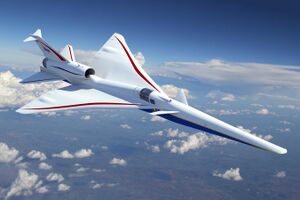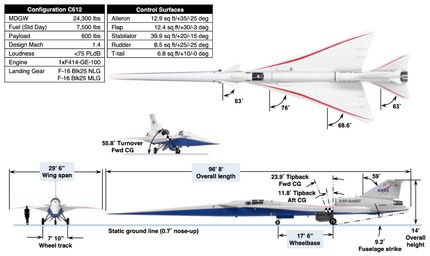Astronomy:Lockheed Martin X-59 QueSST
| X-59 QueSST | |
|---|---|

| |
| Low-Boom Flight Demonstrator | |
| Role | Experimental supersonic aircraft |
| National origin | United States |
| Manufacturer | Lockheed Martin |
| Primary user | NASA |
The Lockheed Martin X-59 QueSST ("Quiet SuperSonic Technology") is an American experimental supersonic aircraft being developed at Skunk Works for NASA's Low-Boom Flight Demonstrator project.[1] Preliminary design started in February 2016, with the X-59 to be delivered to NASA in 2021 for flight testing in 2023. It is expected to cruise at Mach 1.42 (1,510 km/h; 937 mph) at an altitude of 55,000 ft (16,800 m), creating a low 75 Perceived Level decibel (PLdB) thump to evaluate supersonic transport acceptability.
Development
In February 2016, Lockheed Martin was awarded a preliminary design contract, aiming to fly in the 2020 timeframe.[2] A 9% scale model was to be wind tunnel tested from Mach 0.3 to Mach 1.6 between February and April 2017.[3] The preliminary design review was to be completed by June 2017.[4] While NASA received three inquiries for its August 2017 request for proposals, Lockheed was the sole bidder.[5]
On April 2, 2018, NASA awarded Lockheed Martin a $247.5 million contract to design, build and deliver in late 2021 the Low-Boom X-plane. On June 26, 2018, the US Air Force informed NASA it had assigned the X-59 QueSST designation to the demonstrator.[6] By October, NASA Langley had completed three weeks of wind tunnel testing of an 8%-scale model, with high AOAs up to 50° and 88° at very low speed, up from 13° in previous tunnel campaigns.[7] Testing was for static stability and control, dynamic forced oscillations, and laser flow visualization, expanding on previous experimental and computational predictions.[8]
From November 5, 2018, NASA was to begin tests over two weeks to gather feedback: up to eight thumps a day at different locations to be monitored by 20 noise sensors and described by 400 residents, receiving a $25 per week compensation. To simulate the thump, an F/A-18 Hornet is diving from 50,000 ft (15,200 m) to briefly go supersonic for reduced shock waves over Galveston, Texas, an island, and a stronger boom over water.[9] By then, Lockheed Martin had begun machining the first part in Palmdale, California.[10]
In May 2019, the initial major structural parts were loaded in the tooling assembly.[11] In June, assembly was getting underway.[12] The external vision system (XVS) was flight tested on a King Air at NASA Langley.[13] This will be followed by high speed wind tunnel tests to verify inlet performance predictions with a 9.5%-scale model at NASA Glenn Research Center. The critical design review was successfully held on September 9–13, before the IRB report to NASA's Integrated Aviation Systems Program by November.[14] Then, 80–90% of the drawings should be released to engineering.[11] The wing assembly was to be completed in 2020.[12] In December 2020, construction was halfway completed, and first flight was then planned for 2022.[15]
After flight-clearance testing at the Armstrong Flight Research Center, an acoustic validation will include air-to-air Schlieren imaging backlit by the Sun to confirm the shockwave pattern until September 2022.[5] NASA will conduct flight tests over U.S. cities to verify the safety and performance of the X-59's quiet supersonic technologies and evaluate community responses for regulators, which could enable commercial supersonic travel over land.[16]
Community-response flight tests starting in 2023–2025 will be used for ICAO's Committee on Aviation Environmental Protection meeting (CAEP13) establishing a sonic boom standard.[5] The results of the community overflights will be delivered to the ICAO and the FAA in 2027, allowing for a decision to be made to revise the rules on commercial supersonic travel over land in 2028.[17]
NASA reported the installation of the General Electric F-414-GE-100 engine on the X-59, which took place at Lockheed Martin's Skunk Works in Palmdale, California early November 2022. The engine is 13 feet (4.0 m) long and produces 22,000 pounds-force (98 kN) of thrust.[18] As of November 2022 the X-59's first flight is planned for 2023.[19]
Design
The Low-Boom X-plane will be 94 ft (29 m) long with a 29.5 ft (9.0 m) wingspan for a maximum takeoff weight of 32,300 lb (14,700 kg). Propelled by a General Electric F414 engine, it should reach a maximum speed of Mach 1.5 or 990 mph (1,590 km/h), and cruise at Mach 1.42 or 940 mph (1,510 km/h) at 55,000 ft (16,800 m).[20] The cockpit, ejection seat and canopy come from a Northrop T-38 and the landing gear from an F-16.[5] With afterburner its engine will provide 22,000 lbf (98 kN) of thrust.[21]
The ground noise is expected to be around 60 dB(A), about 1/1000 as loud as current supersonic aircraft. This is achieved by using a long, narrow airframe and canards to keep the shock waves from coalescing.[4] It should create a 75 Perceived Level decibel (PLdB) thump on ground, as loud as closing a car door, compared with 105-110 PLdB for the Concorde.[5] The central engine has a top-mounted intake for low boom, but inlet flow distortion due to vortices is a concern.[11]
The flush cockpit means that the long and pointed nose-cone will obstruct all forward vision. The X-59 will use an enhanced flight vision system (EVS), consisting of a forward 4K camera with a 33° by 19° angle of view, which will compensate for the lack of forward visibility.[5][22]
United Technologies subsidiary Collins Aerospace was selected to supply its Pro Line Fusion Cockpit avionics, displaying the boom on the ground, and EVS with long-wave infrared sensors.[23] The Collins EVS-3600 multispectral imaging system, beneath the nose, is used for landing, while the NASA external vision system (XVS), in front of the cockpit, is giving a forward view.[11]
See also
Related lists
References
- ↑ Gipson, Lillian (October 8, 2019). "NASA's Supersonic X-59 QueSST Coming Together at Famed Factory". https://www.nasa.gov/aero/nasa-supersonic-x59-quesst-coming-together-at-famed-factory.
- ↑ Jim Banke (April 22, 2016). "QueSST - New Era of X-Plane Research". NASA. https://fpd.larc.nasa.gov/quesst---new-era-of-x-plane-research.html.
- ↑ Karen Northon (February 24, 2017). "NASA Wind Tunnel Tests X-Plane Design for Quieter Supersonic Jet" (Press release). NASA.
- ↑ 4.0 4.1 Leigh Giangreco (March 22, 2017). "Lockheed and NASA move toward design review for supersonic X-plane". Flightglobal. https://www.flightglobal.com/news/articles/lockheed-and-nasa-move-toward-design-review-for-sup-435437/.
- ↑ 5.0 5.1 5.2 5.3 5.4 5.5 Graham Warwick and Guy Norris (April 4, 2018). "Lockheed To Build NASA's Low-Boom Supersonic X-Plane". Aviation Week & Space Technology. http://aviationweek.com/future-aerospace/lockheed-build-nasa-s-low-boom-supersonic-x-plane.
- ↑ Jim Banke (June 28, 2018). "NASA's experimental supersonic aircraft now known as X-59 QueSST". NASA. https://www.nasa.gov/aero/nasa-experimental-supersonic-aircraft-x-59-quesst.
- ↑ Graham Warwick (October 30, 2018). "NASA Wind-Tunnel Tests Mature Low-Boom X-Plane Design". Aviation Week & Space Technology. http://aviationweek.com/future-aerospace/nasa-wind-tunnel-tests-mature-low-boom-x-plane-design.
- ↑ Chad Trautvetter (November 6, 2018). "NASA Spools Up Low-boom Supersonic Research". AIN online. https://www.ainonline.com/aviation-news/business-aviation/2018-11-06/nasa-spools-low-boom-supersonic-research.
- ↑ Graham Warwick (November 2, 2018). "NASA To Begin Quiet Supersonic Research Flights In Texas". Aviation Week Network. http://aviationweek.com/future-aerospace/nasa-begin-quiet-supersonic-research-flights-texas.
- ↑ Garrett Reim (November 16, 2018). "Lockheed Martin starts work on X-59 Quiet Supersonic aircraft". Flightglobal. https://www.flightglobal.com/news/articles/lockheed-martin-starts-work-on-x-59-quiet-supersonic-453732/.
- ↑ 11.0 11.1 11.2 11.3 Guy Norris (February 19, 2019). "Final Testing Will Clear Way For Assembly Of Supersonic X-59A". Aviation Week & Space Technology. http://aviationweek.com/commercial-aviation/final-testing-will-clear-way-assembly-supersonic-x-59a.
- ↑ 12.0 12.1 Guy Norris (June 18, 2019). "Lockheed Martin Begins Assembly Of X-59 Low-Boom Demonstrator". Aviation Week & Space Technology. https://aviationweek.com/future-aerospace/lockheed-martin-begins-assembly-x-59-low-boom-demonstrator.
- ↑ Graham Warwick (September 23, 2019). "NASA's External Vision System Is Ready For Low-boom Supersonic X-59". Aviation Week & Space Technology. https://aviationweek.com/commercial-aviation/nasa-s-external-vision-system-ready-low-boom-supersonic-x-59.
- ↑ Graham Warwick (September 30, 2019). "The Week In Technology, Sept. 30-Oct. 4, 2019". Aviation Week & Space Technology. https://aviationweek.com/future-aerospace/week-technology-sept-30-oct-4-2019.
- ↑ O'Connor, Kate (December 23, 2020). "NASA Marks Halfway Point In Supersonic X-Plane Construction". AVweb. https://www.avweb.com/aviation-news/nasa-marks-halfway-point-in-supersonic-x-plane-construction/.
- ↑ "NASA Awards Contract to Build Quieter Supersonic Aircraft" (Press release). NASA. April 3, 2018.
- ↑ Hoover, Rachel (March 21, 2022). "Ames' Contributions to the X-59 Quiet SuperSonic Technology Aircraft". NASA. https://www.nasa.gov/feature/ames/x-59.
- ↑ Lydon, Cody (2022-11-14). "Jet Engine Installed on NASA's X-59". http://www.nasa.gov/feature/jet-engine-installed-on-nasa-s-x-59.
- ↑ "Jet Engine Installed on NASA's X-59". November 14, 2022. https://www.nasa.gov/feature/jet-engine-installed-on-nasa-s-x-59/.
- ↑ Jim Banke (April 3, 2018). "New NASA X-Plane Construction Begins Now". NASA. https://www.nasa.gov/lowboom/new-nasa-x-plane-construction-begins-now.
- ↑ Meredith Bruno (June 19, 2018). "Iconic goes supersonic!". GE Aviation. https://bikeshop.geaviation.com/magnificent-technologies/iconic-goes-supersonic/.
- ↑ Trevithick, Joseph (2018-08-23). "NASA's X-59A Quiet Supersonic Test Jet Will Have Zero Forward Visibility For Its Pilot". thedrive.com. http://www.thedrive.com/the-war-zone/23103/nasas-x-59a-quiet-supersonic-test-jet-will-have-zero-forward-visibility-for-its-pilot.
- ↑ Graham Warwick (January 21, 2019). "The Week In Technology, Jan. 21-26, 2019". Aviation Week & Space Technology. http://aviationweek.com/future-aerospace/week-technology-jan-21-26-2019.
External links
- "Quiet Supersonic Technology X-Plane". Lockheed Martin. September 2, 2021. http://www.lockheedmartin.com/us/products/QueSST0.html.
- "Low-Boom Flight Demonstration". NASA. February 15, 2018. https://www.nasa.gov/mission_pages/lowboom/index.html.
- "How X-planes may solve the sonic boom problem". March 27, 2023. https://www.bbc.com/future/article/20230324-how-x-planes-may-solve-the-sonic-boom-problem.



